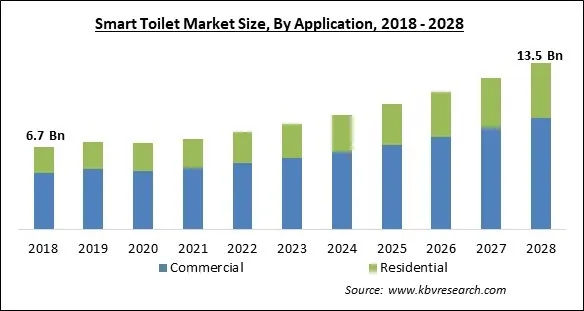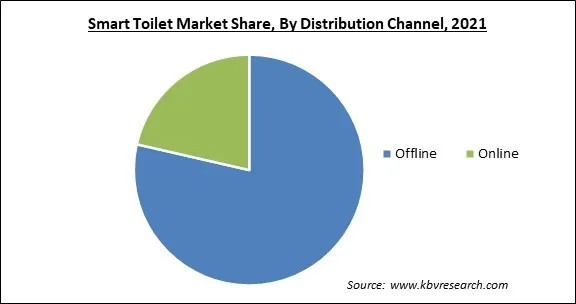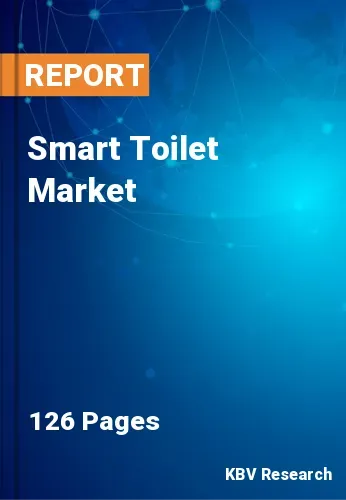The Global Smart Toilet Market size is expected to reach $13.5 billion by 2028, rising at a market growth of 9.3% CAGR during the forecast period.
A smart toilet is a piece of equipment that includes numerous built-in amenities, like a heated seat and an automatic drier. Smart toilets are increasingly becoming the standard in smart homes all over the world. A smart toilet is a high-tech toilet with integrated smart technology, or technology that can connect and interact with the user. These toilets are frequently found in high-tech areas and smart homes across the world.

These gadgets can perform a wide range of tasks, including playing music and flushing at the push of a button, all while conserving valuable water as well as energy. The smart toilet is also known as an intelligent toilet or a modern bidet. It is a form of electronic bidet toilet that combines traditional bidet cleaning as well as the addition of cutting-edge SMART home technology. For a clean and contemporary look, modern intelligent toilets blend electronic bidet cleaning capabilities into a ceramic toilet bowl.
Depending on the manufacturer, make, and model of the toilet, intelligent bidet features can be controlled via voice command, mobile app, or remote-control navigation. A removable toilet seat known as an electronic bidet seat is one of the more affordable choices and is also growing in popularity. Toilets have been around for a very long time, despite being originally considered a luxury. In reality, a flushing toilet with a built-in tank was the first toilet mechanism ever designed. Smart toilets were quickly becoming popular in several countries all over the world.
The Numi, described as the first smart toilet in the world, was introduced by the manufacturer Kohler in 2011. The Numi was ground-breaking because it gave customers the ability to control their own ambient lighting, water temperature, and even music through an integrated radio. Many businesses have now entered the smart toilet market, each creating distinctive features that are significantly useful for people.
Due to the abrupt emergence of the pandemic, the industry for smart toilets almost came to an end. To stop the virus from spreading, the governments of many countries across the world imposed stringent lockdowns. As a result, production and manufacturing were abruptly suspended, and supply networks were upset. In addition, the disposable income of people was also reduced, due to which, their spending capability diminished by a significant rate. Additionally, the lockdown had a direct impact on the offline mode, which accounts for the major portion of the distribution route. Further, the infection also compelled governments worldwide to enforce travel restrictions, which, directly disrupted the supply chain. Owing to all these factors, the growth of the smart toilet market was limited.
Due to the current climate circumstances along with unequal distribution of limited resources, people are becoming more worried about energy conservation. Moreover, these toilets, along with energy, also save a lot of water. Given that they have automated flushes that use measuring techniques to estimate how much water is needed to flush, smart toilets provide better long-term options for water saving. For instance, smart toilets consume as little as 1.6 gallons of water to flush, compared to the 5 to 7 gallons used by conventional toilets.

One of the major factors that are rapidly increasing the adoption of smart toilets all over the world is the rising number of technological advancements in smart toilets due to the widespread modernization. Voice-activated equipment and IoT technology are becoming more common in the sector. To improve the user experience in restrooms, various major companies are frequently incorporating a variety of cutting-edge hygiene technology, including UV lighting, Bluetooth connectivity, auto-open seat covers, auto-flush, and much more.
The smart toilet is a completely new class of electrical appliance that is both expensive as well as highly sophisticated. Because they are technological products, smart toilets are more expensive than standard toilets. Additionally, their maintenance is more expensive than their installation cost. Small-sized toilets cannot use smart toilets. Since the smart toilet takes up a fair amount of space, it is typically not recommended to deploy one in a tiny bathroom. A smart toilet takes up space and makes it difficult to place other toiletries or household appliances, so installing one in a tiny bathroom would make the area appear extremely congested.
By Application, the Smart Toilet Market is bifurcated into Residential and Commercial. In 2018, the commercial segment acquired the largest revenue share of the smart toilet market. To offer hygienic services to their customers, several upscale restaurants, hotels, bars, and shopping centers have installed smart toilets. Additionally, the smart toilet is considered as a luxury item that may be installed in upscale business spaces. The increasing number of luxury hotels and restaurants is one of the major factors that is driving the growth of the segment.
On the basis of Distribution Channel, the Smart Toilet Market is divided into Online and Offline. In 2021, the online segment witnessed a substantial revenue share of the smart toilet market. The growth of the segment is driven by the fact that these channels offer a variety of alluring features, like free cashback or membership, door-to-door delivery, and simple return procedures, which are chosen by customers, especially millennial. Through online channels, it is simple to comprehend the attributes of the products and compare their costs.
| Report Attribute | Details |
|---|---|
| Market size value in 2021 | USD 7.3 Billion |
| Market size forecast in 2028 | USD 13.5 Billion |
| Base Year | 2021 |
| Historical Period | 2018 to 2020 |
| Forecast Period | 2022 to 2028 |
| Revenue Growth Rate | CAGR of 9.3% from 2022 to 2028 |
| Number of Pages | 126 |
| Number of Tables | 240 |
| Report coverage | Market Trends, Revenue Estimation and Forecast, Segmentation Analysis, Regional and Country Breakdown, Companies Strategic Developments, Company Profiling |
| Segments covered | Application, Distribution Channel, Region |
| Country scope | US, Canada, Mexico, Germany, UK, France, Russia, Spain, Italy, China, Japan, India, South Korea, Singapore, Malaysia, Brazil, Argentina, UAE, Saudi Arabia, South Africa, Nigeria |
| Growth Drivers |
|
| Restraints |
|
Region-Wise, the Smart Toilet Market is analyzed across North America, Europe, Asia-Pacific, and LAMEA. In 2021, Europe registered the highest revenue share of the smart toilet market. The expansion of the smart toilet industry is being driven by increasing consumer spending on ensuring bathroom hygiene. A significant portion of the population in Germany, as well as the United Kingdom, prefers to have an intelligent toilet seat installed rather than pull the seat manually, which is unclean. Moreover, an increasing number of concerns over water conservation in the region is also a key factor that is accelerating the adoption of smart toilets in the region.
Free Valuable Insights: Global Smart Toilet Market size to reach USD 13.5 Billion by 2028
The market research report covers the analysis of key stake holders of the market. Key companies profiled in the report include Xiaomi Corporation, Masco Corporation (Delta Faucet Company), LIXIL Group Corporation (Grohe AG), Roca Sanitario, SA (Roca Corporacion Empresarial, SA), Kohler Co., Toto Ltd., Bradley Corporation, Duravit AG, Wellis Magyarország Zrt., and Fortune Brands Home & Security, Inc.
By Application
By Distribution Channel
By Geography


The Smart Toilet Market size is projected to reach USD 13.5 billion by 2028.
Increased Energy Efficiency And Water Savings are driving the market in coming years, however, Higher Installation And Maintenance Cost restraints the growth of the market.
Xiaomi Corporation, Masco Corporation (Delta Faucet Company), LIXIL Group Corporation (Grohe AG), Roca Sanitario, SA (Roca Corporacion Empresarial, SA), Kohler Co., Toto Ltd., Bradley Corporation, Duravit AG, Wellis Magyarország Zrt., and Fortune Brands Home & Security, Inc.Inc.
The expected CAGR of the Smart Toilet Market is 9.3% from 2022 to 2028.
The Offline segment acquired maximum the Global Smart Toilet Market by Distribution Channel in 2021 hereby, achieving a market value of $10.4 billion by 2028.
The Europe market dominated the Global Smart Toilet Market by Region in 2021, and would continue to be a dominant market till 2028; thereby, achieving a market value of $5 billion by 2028.
Our team of dedicated experts can provide you with attractive expansion opportunities for your business.

